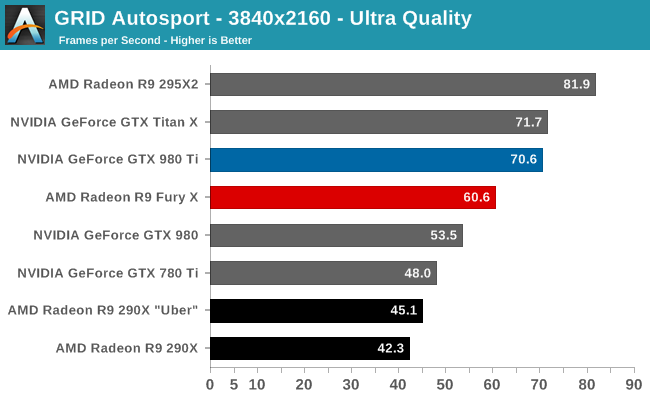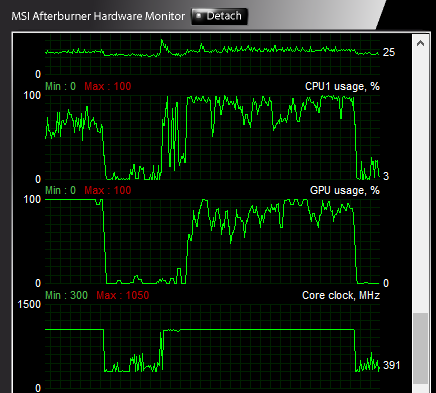The AMD Radeon R9 Fury X Review: Aiming For the Top
by Ryan Smith on July 2, 2015 11:15 AM ESTGRID Autosport
For the racing game in our benchmark suite we have Codemasters’ GRID Autosport. Codemasters continues to set the bar for graphical fidelity in racing games, delivering realistic looking environments with layed with additional graphical effects. Based on their in-house EGO engine, GRID Autosport includes a DirectCompute based advanced lighting system in its highest quality settings, which incurs a significant performance penalty on lower-end cards but does a good job of emulating more realistic lighting within the game world.


Unfortunately for AMD, after a streak of wins and ties for AMD, things start going off the rails with GRID, very off the rails.
At 4K Ultra this is AMD’s single biggest 4K performance deficit; the card trails the GTX 980 Ti by 14%. The good news is that in the process the card cracks 60fps, so framerates are solid on an absolute basis, though there are still going to be some frames below 60fps for racing purists to contend with.
Where things get really bad is at 1440p, in a situation we have never seen before in a high-end AMD video card review. The R9 Fury X gets pummeled here, trailing the GTX 980 Ti by 30%, and even falling behind the GTX 980 and GTX 780 Ti. The reason it’s getting pummeled is because the R9 Fury X is CPU bottlenecked here; no matter what resolution we pick, the R9 Fury X can’t spit out more than about 82fps here at Ultra quality.
With GPU performance outgrowing CPU performance year after year, this is something that was due to happen sooner or later, and is a big reason that low-level APIs are about to come into the fold. And if it was going to happen anywhere, it would happen with a flagship level video card. Still, with an overclocked Core i7-4960X driving our testbed, this is also one of the most powerful systems available with respect to CPU performance, so AMD’s drivers are burning an incredible amount of CPU time here.
Ultimately GRID serves to cement our concerns about AMD’s performance at 1440p, as it’s very possible that this is the tip of the iceberg. DirectX 11 will go away eventually, but it will still take some time. In the meantime there are a number of 1440p gamers out there, especially with R9 Fury X otherwise being such a good fit for high frame rate 1440p gaming. Perhaps the biggest issue here is that this makes it very hard to justify pairing 1440p 144Hz monitors with AMD’s GPUs, as although 82.6fps is fine for a 60Hz monitor, these CPU issues are making it hard for AMD to deliver framerates more suitable/desirable for those high performance monitors.











458 Comments
View All Comments
Navvie - Thursday, July 2, 2015 - link
"Which is not say I’m looking" (paragraph 5, first line).Missing a "to" I think.
watzupken - Thursday, July 2, 2015 - link
Brilliant review. Well worth the wait. Thanks Ryan.Taracta - Thursday, July 2, 2015 - link
ROPs, ROPs, ROPs! Hows can they ~ double everything else and keep the same amount of ROPs and expect to win?Thatguy97 - Thursday, July 2, 2015 - link
maybe something to do with cost or yieldtipoo - Thursday, July 2, 2015 - link
They literally hit the size limits interposers can scale up to with this chip - so they can't make it any bigger to pack more transistors for more ROPs, until a die shrink. So they decided on a tradeoff, favouring other things than ROPs.Kevin G - Thursday, July 2, 2015 - link
They had a monster shader count and likely would be fine if they went to 3840 max to make room for more ROPs. 96 or 128 ROPs would have been impressive and really made this chip push lots of pixels. With HBM and the new delta color compression algorithm, there should be enough bandwidth to support these additional ROPs without bottle necking them.AMD also scaled the number of TMUs with the shaders but it likely wouldn't have hurt to have increased them by 50% too. Alternatively AMD could have redesigned the TMUs to have better 16 bit per channel texture support. Either of these changes would have put the texel throughput well beyond the GM200's theoretical throughput. I have a feeling that this is one of the bottlenecks that helps the GM200 pull ahead of Fiji.
tipoo - Friday, July 3, 2015 - link
Not saying it was the best tradeoff - just explaining. They quite literally could not go bigger in this case.testbug00 - Sunday, July 5, 2015 - link
the performances scaling as resolution increase is better than Nvidia, implying the ROPs aren't the bottleneck...chizow - Sunday, July 5, 2015 - link
No, that implies the shaders are the bottleneck at higher resolutions while ROP/fillrate/geometry remained constant. While Nvidia's bottleneck at lower resolutions isn't shader bound but their higher ROP/fillrate allows them to realize this benefit in actual FPS, AMD's ROPs are saturated and simply can't produce more frames.Ryan Smith - Thursday, July 2, 2015 - link
Right now there's not a lot of evidence for R9 Fury X being ROP limited. The performance we're seeing does not have any tell-tale signs of being ROP-bound, only hints here and there that may be the ROPs, or could just as well be the front-end.While Hawaii was due for the update, I'm not so sure we need to jump up in ROPs again so soon.